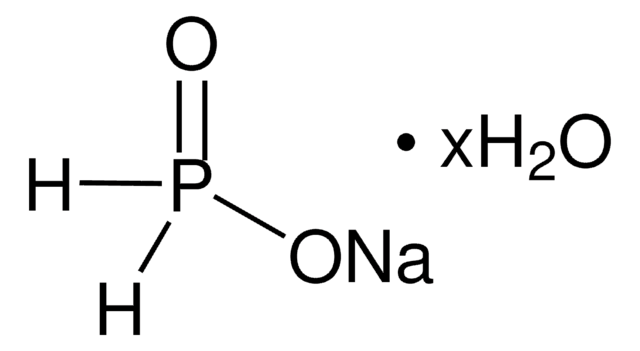04434
Sodium hypophosphite
puriss., meets analytical specification of BPC63, anhydrous, 98-101%
About This Item
Recommended Products
grade
puriss.
Assay
98-101%
form
powder or crystals
quality
meets analytical specification of BPC63
impurities
≤0.001% heavy metals (as Pb)
≤0.2% free alkali (as CaO)
loss
≤1% loss on drying, 105 °C, 2 h
solubility
water: soluble 909 g/L at 30 °C
density
1.77 g/cm3 at 20 °C
anion traces
chloride (Cl-): ≤200 mg/kg
sulfate (SO42-): ≤200 mg/kg
cation traces
As: ≤2 mg/kg
Fe: ≤10 mg/kg
SMILES string
[Na+].[O-][PH2]=O
InChI
1S/Na.H3O2P/c;1-3-2/h;3H2,(H,1,2)/q+1;/p-1
InChI key
SIGUVTURIMRFDD-UHFFFAOYSA-M
Looking for similar products? Visit Product Comparison Guide
Related Categories
General description
Application
- Synthesis and characterization of chitosan-copper nanocomposites and their catalytic properties for 4-nitrophenol reduction.: This study explores the synthesis of chitosan-copper nanocomposites using sodium hypophosphite as a reducing agent. The resulting nanocomposites are characterized and their catalytic properties for the reduction of 4-nitrophenol are evaluated, demonstrating the utility of sodium hypophosphite in catalytic applications (Pang et al., 2024).
- The Durable Chitosan Functionalization of Cellulosic Fabrics.: This research focuses on the durable functionalization of cellulosic fabrics with chitosan using sodium hypophosphite as a cross-linking agent. The study highlights the improved properties of the fabrics, showcasing sodium hypophosphite′s role in textile enhancement (Flinčec Grgac et al., 2023).
- Hypophosphite cross-linked starch succinate/chitosan membranes as alternative for packaging and pharmaceutical application.: The study investigates the development of starch succinate/chitosan membranes cross-linked with sodium hypophosphite, proposing these materials as potential alternatives for packaging and pharmaceutical applications (Bajer, 2023).
- Tensile Strength Improvements of Ramie Fiber Threads through Combination of Citric Acid and Sodium Hypophosphite Cross-Linking.: This research improves the tensile strength of ramie fiber threads by combining citric acid and sodium hypophosphite for cross-linking, demonstrating significant enhancements in fiber properties for industrial applications (Wulandari et al., 2023).
- Nickel-Catalyzed Sodium Hypophosphite-Participated Direct Hydrophosphonylation of Alkyne toward H-Phosphinates.: This study demonstrates a novel nickel-catalyzed hydrophosphonylation of alkynes using sodium hypophosphite. The research showcases the efficiency of sodium hypophosphite in producing H-phosphinates, highlighting its significance in chemical synthesis (Qian et al., 2023).
Storage Class Code
13 - Non Combustible Solids
WGK
WGK 2
Flash Point(F)
Not applicable
Flash Point(C)
Not applicable
Certificates of Analysis (COA)
Search for Certificates of Analysis (COA) by entering the products Lot/Batch Number. Lot and Batch Numbers can be found on a product’s label following the words ‘Lot’ or ‘Batch’.
Already Own This Product?
Find documentation for the products that you have recently purchased in the Document Library.
Customers Also Viewed
Our team of scientists has experience in all areas of research including Life Science, Material Science, Chemical Synthesis, Chromatography, Analytical and many others.
Contact Technical Service











